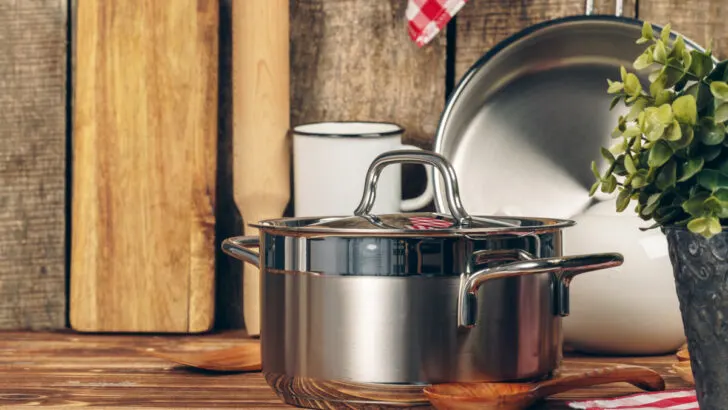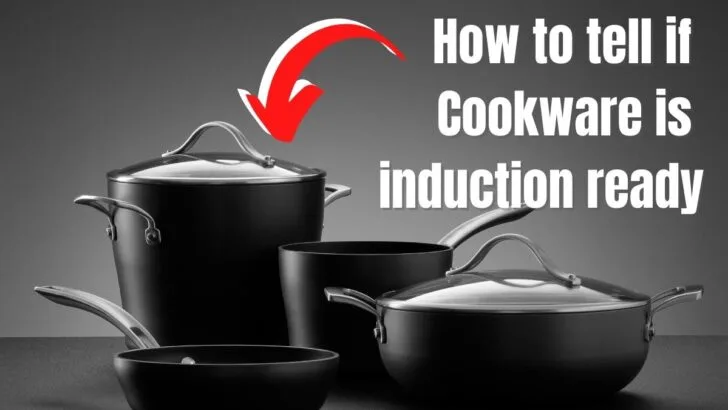Induction cooking has been a game-changer for a lot of households and professional kitchens, but how can you tell if cookware is induction-ready?
You can tell if cookware is induction-ready by looking for a coil symbol at the base of the pot or pan. You can also place a magnet on the bottom surface of the cookware, and if the magnet sticks to the surface, then you will know the cookware is suitable for an induction stove.
Read on to learn more about how you can identify if your cookware is induction-ready by implementing a simple test.
What Is Induction Cooking?
Induction cooking relies on electromagnetic energy to heat cookware and cook food. An induction stove has a copper coil underneath the heating surface which will transfer electromagnetic energy directly to your cookware.
This is considered to be a more efficient and environmentally-friendly approach for cooking compared to traditional gas and even electric stoves. One of the only drawbacks to cooking on an induction stove is that you must have induction-ready cookware for it to work.
How To Tell If Cookware Is Induction-Ready
Before you place any pot or pan on your induction stove, you need to confirm that the cookware is induction-ready. There are a couple of different methods that you can use for this, depending on the type of cookware that you use.
Coil Symbol at the Bottom of Cookware
Induction cooking is becoming increasingly popular, and many companies are now designing cookware that is specifically designed for these kinds of stoves. Virtually all cookware built for induction cooking will have a coil symbol on its bottom surface.

All you need to do is flip the pot or pan over and look for a coil. Older induction cookware may not feature this symbol, but all new pots and pans designed for induction cooking will have a coil.
Test the Cookware With a Magnet
Given that induction cooking relies on electromagnetic energy, all induction cookware will react to magnets. You can test if your cookware is induction-ready by placing a magnet on the bottom side of your pots and pans.
A simple fridge magnet is perfect for performing this test. Simply flip your cookware over to see if it reacts to the magnet. If there is a strong pull, then you will know the cookware is induction-ready.
However, if there is only a light pull from the magnet, the cookware may not be ideal for an induction stove.
What Cookware is Induction-Ready?
There are plenty of cookware brands that specialize in designing pots and pans that are specifically intended for induction cooking. With that said, you may have plenty of cookware laying around the house that is induction-ready but you simply did not realize it.
If you know the material that your cookware is made out of, you can easily tell if it is induction-ready. The following materials are suitable for induction cooking:
- Cast iron
- Magnetic stainless steel
In addition, most brands that advertise “fully clad” cookware will be induction ready. As always, if you are ever in doubt, you can always perform a magnet test to confirm if the cookware is okay for cooking on an induction stove.
What Cookware is Not Induction-Ready?
Although it can be easy to assume that any metal pan is induction-ready, that is simply not the case. Induction-ready cookware needs to be made out of metal materials that will provide a strong enough electromagnetic reaction to generate heat.
A lot of metallic cookware is not suitable for induction cooking, which you can confirm by checking for the coil symbol at the base of the pot or pan or by testing the cookware with a magnet, as mentioned above.
Alternatively, if you know the material that the cookware is made out of, you can rule out if it’s induction ready immediately. The following materials are not suitable for induction cooking:
- Aluminum
- Copper
- Glass
- Stainless steel
What Happens If You Use Non-Induction Cookware on an Induction Stove?
Given that induction stoves are only intended to be used with induction cookware, you may be worried about your stove or cookware getting damaged if you use non-induction cookware. However, this will not be the case.
Induction stoves rely on the transfer of electromagnetic energy to generate heat. If the cookware that you place on the stove is not induction-ready, there will simply be no reaction. The stove will not generate heat and your pots or pans will stay cold.
With that said, placing cookware that only has a light electromagnetic reaction can result in very slow cooking times. In addition, relying on cheap induction-ready cookware can have a damaging effect on the pots and pans.
Poor quality cookware with a thin layer of induction-ready material can become bent due to the heat from the stove. This type of cookware is generally not very long-lasting and will get damaged after just 1 or 2 years.
Benefits of Using Induction-Ready Cookware
Induction cooking has been around for a while, but its popularity has seen a sharp increase in recent years.
Traditional stoves such as gas and electric have proven to be less efficient and more damaging to the environment, which is why many homeowners are making the transition over to induction cooking. These are the benefits of using induction-ready cookware:
- Faster meal preparation
- Better temperature control
- Cookware is easier to clean
- Environmentally-friendly
The bottom line is that induction-ready cookware makes cooking a lot more practical and convenient, with fewer damaging effects on the environment.
Key Takeaways to Know If Cookware is Induction-Ready
You can tell if cookware is induction-ready by looking for a coil symbol at the base of the pot or pan, or by placing a magnet on the bottom surface of the cookware.
Magnets will stick to induction-ready cookware confirming that they are suitable for an induction stove.
Common materials used for induction-ready cookware include cast iron and magnetic stainless steel.


